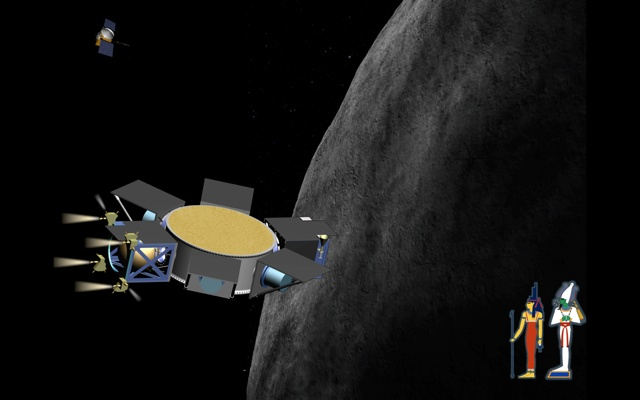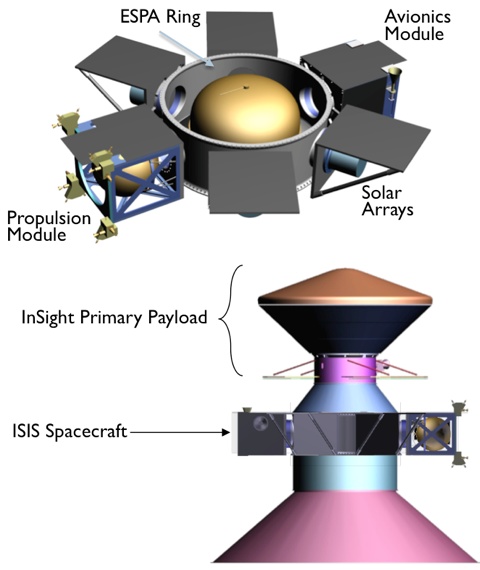Mars Mission May Carry Asteroid-Smashing Probe in 2016

FLAGSTAFF, Ariz. — When a NASA mission to study Mars' deep interior blasts off in 2016, it may also carry a tag-along experiment that will slam an impactor into a potentially hazardous asteroid.
Scientists are studying the possibility of adding the asteroid-deflection effort — dubbed Impactor for Surface and Interior Science (ISIS) — to NASA's InSight Mars mission, which is slated to launch a lander toward the Red Planet in March 2016.
Once set loose in space, ISIS is designed to slam into the asteroid target of the already-on-the-books NASA mission Osiris-Rex, which aims to launch a robotic probe toward potentially dangerous asteroid 1999 RQ36 in September 2016. [Gallery: Potentially Dangerous Asteroids]
Hardware alignment
"This opportunity with a free launch and the observer spacecraft already at the asteroid is like a planetary alignment. It almost never happens," said Steven Chesley of the solar system dynamics group at NASA's Jet Propulsion Laboratory in Pasadena, Calif. who is leading the potential ISIS mission.
Chesley discussed ISIS here during the 2013 International Academy of Astronautics' Planetary Defense Conference, which ran from April 15 to 18.
NASA's Osiris-Rex mission has an amalgam of asteroid-studying duties, as the name suggests: Origins, Spectral Interpretation, Resource Identification, Security, Regolith Explorer. The Osiris-Rex mission is a partnership involving the University of Arizona, NASA’s Goddard Space Flight Center and Lockheed Martin, with collaborators worldwide.
Breaking space news, the latest updates on rocket launches, skywatching events and more!
The Osiris-Rex spacecraft is scripted for travel to 1999 RQ36, a near-Earth carbonaceous asteroid. The probe will rendezvous with that space rock in 2019-2021, gathering and returning specimens of the object for delivery to Earth in 2023.
The new plan being devised has ISIS arriving after Osiris-Rex has done its science work at the asteroid. ISIS would smack at high velocity into the near-Earth asteroid, creating a crater tens of meters in diameter.
Celestial wallop
From a safe vantage point, Osiris-Rex would observe the celestial wallop.
After debris clears, the probe would then approach the asteroid and image the crater for comparative analysis of previously mapped terrain. In addition, spectra of the pristine material exposed by the impact could be obtained.
The purposeful crash of ISIS into the asteroid is viewed, in part, as a seismic experiment. Global alterations (toppled rocks, landslides) due to shock waves and reverberations are anticipated, as is lofting of material far from the impact site. Just how much the asteroid is deflected from its course will also be measured.
The outcome of the ISIS impact, and the data it generates, are meant to showcase planetary defense aspects of an asteroid deflection experiment, like demonstrating terminal guidance capability.
ISIS also spotlights important science return per dollar, advocates say.
On the exploration side, ISIS squarely addresses numerous critical and strategic knowledge gaps for human exploration of near-Earth asteroids, Chesley told conference attendees.
Crosshairs on Earth
Why all the fuss about asteroid 1999 RQ36?
For one, the security aspect of the Osiris-Rex mission centers on calculations of the space rock’s future orbits, and its potential to collide with Earth. Those appraisals indicate that the object has the highest impact probabilities in the next few centuries of any known asteroid.
So studying 1999 RQ36's orbit and composition can help scientists better understand the threat posed by the asteroid, Chesley said..
Armed with that new data, policymakers would be able to decide what steps, if any, should be taken to alleviate the chance of 1999 RQ36 striking our home planet.
Quick turnaround
"We are not past our window for implementing this mission," Chesley said, "but there's not a lot of time." The hope is to get an ISIS go-ahead in the fall, he said.
NASA Headquarters is footing the bill on the study to bring ISIS to a level of maturity, Chesley said — work that would enable a quick turnaround into full-scale development.
Chesley said that coarse estimates put the ISIS cost somewhat north of $100 million.
"Careful scrubbing of cost estimates is part of the study plan that is getting underway, and I am confident that we can keep it close to the $100 million price point," he said.

Leonard David is an award-winning space journalist who has been reporting on space activities for more than 50 years. Currently writing as Space.com's Space Insider Columnist among his other projects, Leonard has authored numerous books on space exploration, Mars missions and more, with his latest being "Moon Rush: The New Space Race" published in 2019 by National Geographic. He also wrote "Mars: Our Future on the Red Planet" released in 2016 by National Geographic. Leonard has served as a correspondent for SpaceNews, Scientific American and Aerospace America for the AIAA. He has received many awards, including the first Ordway Award for Sustained Excellence in Spaceflight History in 2015 at the AAS Wernher von Braun Memorial Symposium. You can find out Leonard's latest project at his website and on Twitter.


